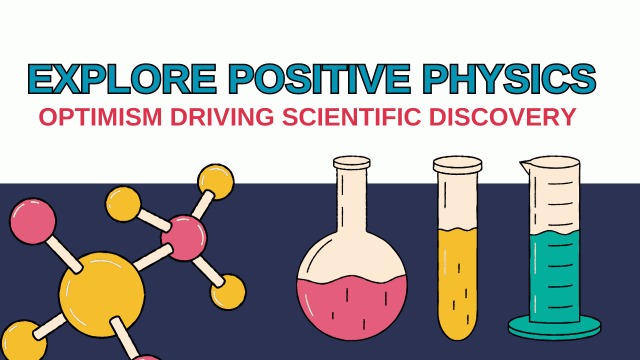Positive Physics Unleashed: Optimism Driving Scientific Discovery
Introduction to Positive Physics
As a physicist and researcher, I have always been fascinated by the power of positivity in scientific inquiry. Positive physics is a relatively new concept that emphasizes the role of optimism and positive thinking in driving scientific discovery. This approach to physics research has gained popularity in recent years, and for good reason.

In this editorial, I will explore the impact of positive physics on scientific discovery, provide examples of positive physics in action, discuss the benefits of approaching science with a positive mindset, and offer tips on how to cultivate optimism in scientific research.
Positive physics is based on the idea that our thoughts and emotions can influence the outcome of scientific experiments. When we approach a research question with a positive mindset, we are more likely to see solutions and opportunities that we may have otherwise missed. In contrast, negative thinking can limit our ability to see new possibilities and hinder scientific progress.
Research has shown that optimism can have a significant impact on scientific discovery. A study published in the journal Nature found that scientists who were more optimistic were more likely to make breakthrough discoveries. The study also found that scientists who were more optimistic were more likely to collaborate with other researchers and were more resilient in the face of setbacks.
Examples of Positive Physics in Action
Positive physics can be seen in action in many areas of science. For example, the field of quantum mechanics is founded on the idea that particles can exist in multiple states at the same time. This idea was initially met with skepticism and resistance, but researchers who embraced the concept of positive physics were able to make significant breakthroughs in the field.
Another example of positive physics in action is the development of the atomic bomb. Despite the destructive nature of the weapon, the scientists who worked on the Manhattan Project were driven by a sense of optimism and a desire to end World War II. This optimism fueled their research and ultimately led to the successful creation of the bomb.

Approaching science with a positive mindset can have many benefits. For one, it can lead to more creative and innovative research. When we are optimistic, we are more likely to see new possibilities and to think outside the box. This can lead to breakthrough discoveries that might not have been possible with a more narrow-minded approach.
Positive thinking can also lead to better collaboration among researchers. When we are optimistic, we are more likely to seek out the input and expertise of others. This can lead to more diverse perspectives and a more comprehensive understanding of the research question.
Finally, a positive mindset can help researchers overcome setbacks and challenges. Inevitably, scientific research will encounter obstacles and setbacks. However, researchers who approach these challenges with a positive attitude are more likely to persevere and ultimately succeed.
Cultivating optimism in scientific research is not always easy, but there are steps that researchers can take to foster a positive mindset. For one, it is important to focus on the potential benefits and implications of the research. By keeping the big picture in mind, researchers can stay motivated and optimistic about the potential impact of their work.
Additionally, it is beneficial to acknowledge and appreciate minor accomplishments along the path. When researchers make progress, even if it is incremental, it is important to acknowledge and celebrate these accomplishments. This can help to maintain a positive outlook and keep researchers motivated throughout the research process.
Finally, collaboration is key to cultivating optimism in scientific research. By working with others and seeking out diverse perspectives, researchers can maintain a sense of optimism and a belief in their ability to make a difference.

Collaboration is a central component of positive physics. When researchers work together, they are able to share ideas, expertise, and resources. This can lead to more innovative and comprehensive research, as well as a greater sense of optimism and motivation.
Collaboration can take many forms, from interdisciplinary research teams to international collaborations. Regardless of the specific form it takes, collaboration is essential for positive physics research. By working together, researchers can overcome obstacles and challenges, share insights and expertise, and ultimately make breakthrough discoveries that might not have been possible on their own.
Scientific research is not always a smooth process. Researchers will inevitably encounter challenges and setbacks along the way. However, by maintaining a positive mindset and a sense of determination, researchers can overcome these obstacles and ultimately succeed.
One key to overcoming challenges and setbacks is to maintain a sense of perspective. When setbacks occur, it is important to take a step back and reevaluate the research question and the approach being taken. By being open to new ideas and approaches, researchers can find new solutions to old problems.
It is also important to maintain a sense of optimism and determination in the face of setbacks. By focusing on the potential benefits and implications of the research, researchers can stay motivated and committed to their work, even in the face of adversity.

The Future of Positive Physics: Potential Applications and Advancements
Positive physics has the potential to revolutionize many areas of science. By emphasizing the role of optimism and positive thinking in scientific inquiry, positive physics can lead to more innovative and comprehensive research, as well as breakthrough discoveries that might not have been possible with a more narrow-minded approach.
As the field of positive physics continues to evolve, we can expect to see new applications and advancements in many areas of science. From quantum mechanics to biotechnology, positive physics has the potential to drive breakthrough discoveries and transform the way we approach scientific research.
For researchers who are interested in exploring positive physics, there are many resources and tools available. One great place to start is with the Positive Psychology Center at the University of Pennsylvania. The center offers a variety of resources and research on the role of positivity in many areas of life, including scientific research.
Another valuable resource for researchers is the Association for Positive Psychology in Physics. This organization is dedicated to promoting the use of positive psychology in the field of physics and offers a variety of resources and networking opportunities for researchers interested in pursuing positive physics research.

Conclusion: Embracing Optimism for a Brighter Scientific Future
In conclusion, positive physics has the potential to revolutionize many areas of science. By emphasizing the role of optimism and positive thinking in scientific inquiry, positive physics can lead to more innovative and comprehensive research, as well as breakthrough discoveries that might not have been possible with a more narrow-minded approach.
As researchers, it is important to cultivate a sense of optimism and a belief in the potential impact of our work. By approaching scientific research with a positive mindset and a determination to make a difference, we can overcome obstacles and challenges and ultimately succeed in making breakthrough discoveries that have the potential to change the world. So let us embrace optimism for a brighter scientific future.
FAQ:
What is positive physics?
Positive physics is a relatively new concept that emphasizes the role of optimism and positive thinking in driving scientific discovery.
Research has shown that optimism can have a significant impact on scientific discovery. Scientists who were more optimistic were more likely to make breakthrough discoveries.
What are some examples of positive physics in action?
Positive physics can be seen in action in many areas of science, including the development of the atomic bomb and the field of quantum mechanics.
Researchers can cultivate optimism in scientific research by focusing on the potential benefits and implications of the research, celebrating small victories along the way, and collaborating with others.
What is the future of positive physics?
Positive physics has the potential to revolutionize many areas of science, from quantum mechanics to biotechnology, and to drive breakthrough discoveries that have the potential to change the world.
Get access all prompts: https://bitly.com/uy4i







